Frederick Walker (1840-1875) stands as a significant, albeit tragically short-lived, figure in the landscape of 19th-century British art. A master of both watercolour and oil, he carved a unique niche for himself, blending meticulous observation with poetic sensibility. His work, often imbued with a gentle melancholy and a deep empathy for his subjects, captured the nuances of Victorian rural life and touched upon broader themes of youth, age, and social reality. Though his career spanned little more than a decade and a half, his influence resonated with a generation of artists, and his legacy continues to be appreciated for its distinctive charm and profound humanity.
Early Life and Artistic Awakening
Born in Marylebone, London, on May 26, 1840, Frederick Walker was one of a pair of twins. His father, William Henry Walker, was a jeweler, and his mother, Ann (née Powell) Walker, was an accomplished embroiderer, a skill that perhaps subtly informed her son's later appreciation for detailed craftsmanship. Frederick's father passed away when he was young, leaving his mother to raise the family. From an early age, Walker displayed a precocious talent for drawing, often spending his time diligently copying prints and engravings, a common method of self-teaching for aspiring artists of the period. This early practice honed his observational skills and his ability to render form and detail with accuracy.
His formal artistic education began somewhat unconventionally. In 1855, at the age of fifteen, he was placed in an architect's office in Gower Street, run by a Mr. Baker. While architecture was not his ultimate calling, the discipline of precise draughtsmanship required in such a setting would have undoubtedly benefited his artistic development. Concurrently, he pursued his passion for art by attending evening classes at the British Museum, studying classical sculpture, and later, from 1857, at the Royal Academy Schools as a probationer, though he did not enroll as a full student immediately.
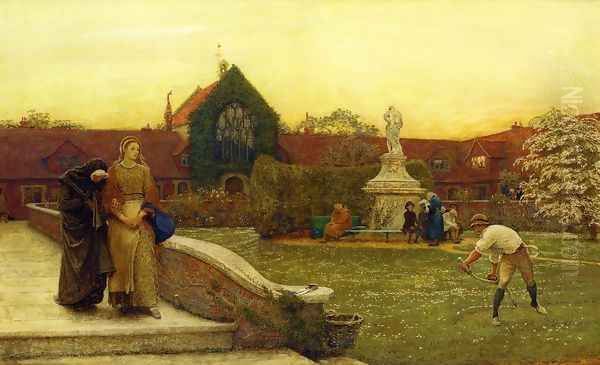
A pivotal moment in Walker's formative years came in 1858 when he became an apprentice to Josiah Wood Whymper, a prominent wood engraver and watercolourist. Whymper's studio was a bustling hub of artistic activity, and it was here that Walker truly immersed himself in the practicalities of illustration and printmaking. The meticulous demands of wood engraving – the precision of line, the careful consideration of black and white masses, and the translation of tonal values – had a profound and lasting impact on his artistic style, even when he later transitioned to painting. During his two-year apprenticeship, he not only mastered the technical aspects of the craft but also formed connections with other young artists who would become his contemporaries and, in some cases, lifelong friends.
The Illustrator's Craft
Walker's professional career initially blossomed in the field of illustration, a thriving industry in Victorian Britain fueled by the proliferation of illustrated magazines and books. After leaving Whymper's tutelage, he quickly established himself as a sought-after illustrator. His drawings appeared in popular periodicals such as Once a Week, Good Words, The Cornhill Magazine, and Everybody's Magazine. His ability to capture character, convey narrative, and create atmospheric settings made his work highly desirable to authors and publishers alike.
One of his most significant early collaborations was with the celebrated novelist William Makepeace Thackeray. Walker provided illustrations for Thackeray's later novels, notably The Adventures of Philip (serialized in The Cornhill Magazine from 1861-1862) and Denis Duval (left unfinished at Thackeray's death in 1863). Thackeray held Walker's talent in high regard, appreciating the young artist's sympathetic interpretations of his characters and scenes. Walker's illustrations for Thackeray were not mere decorations but integral components that enhanced the reader's engagement with the text, often adding layers of emotional depth and visual richness.
His work as an illustrator was characterized by a delicate yet firm line, a keen eye for detail, and a remarkable ability to convey emotion through gesture and expression. He often depicted scenes of everyday life, infusing them with a sense of poetry and quiet dignity. This period was crucial for Walker, as it allowed him to refine his compositional skills, experiment with narrative techniques, and develop his understanding of human character, all of which would inform his later paintings. He was part of what became known as the "Idyllic School" or "Poetic Realists" of the 1860s, a group of artists, many of whom also worked as illustrators, who favored rural subjects, often tinged with sentiment and nostalgia.
Transition to Painting: Watercolours and Oils
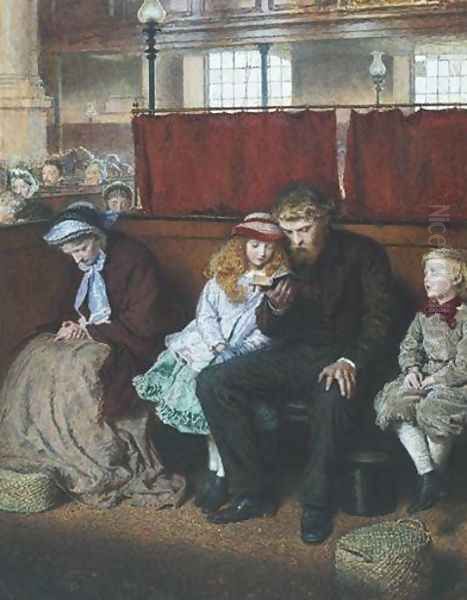
While illustration provided Walker with a steady income and a growing reputation, his artistic ambitions extended to painting. He began to exhibit watercolours, a medium in which he would achieve particular distinction. His training in wood engraving, with its emphasis on tonal control, translated exceptionally well to watercolour, allowing him to create works of great subtlety and luminosity. In 1862, his watercolour Strange Faces, depicting a group of children peering through a railing, was exhibited and garnered positive attention. This work showcased his ability to capture fleeting expressions and create a compelling, slightly enigmatic scene from an ordinary moment.
His success in watercolour led to his election as an Associate of the Royal Watercolour Society (then known as the Society of Painters in Water Colours) in 1864, and he became a full member in 1866. He was a regular and admired contributor to their exhibitions. His watercolours often depicted pastoral scenes, figures in landscapes, and moments of quiet contemplation, rendered with a distinctive technique that combined precise drawing with delicate washes of colour. He often used bodycolour (gouache) to achieve opacity and texture, a method that gave his watercolours a richness and solidity approaching that of oil painting.
Walker made his debut as an oil painter at the Royal Academy in 1863 with the work The Lost Path. This painting, depicting a distressed woman and child lost in a snowy landscape, signaled his arrival as a serious contender in the more prestigious medium of oil. It demonstrated his ability to handle complex compositions, convey strong emotion, and create a powerful atmospheric effect. The painting was well-received and marked a significant step in his transition from illustrator to painter. Over the following years, he would continue to exhibit oils at the Royal Academy, further solidifying his reputation.
Artistic Style and Dominant Themes
Frederick Walker's artistic style is a unique amalgamation of Pre-Raphaelite attention to detail, classical compositional sense, and a deeply personal, poetic vision. He was not strictly aligned with any single artistic movement but drew inspiration from various sources, forging a path that was distinctly his own. His early work as an engraver instilled in him a love for precision and a strong sense of line, which remained evident even in his most painterly works.
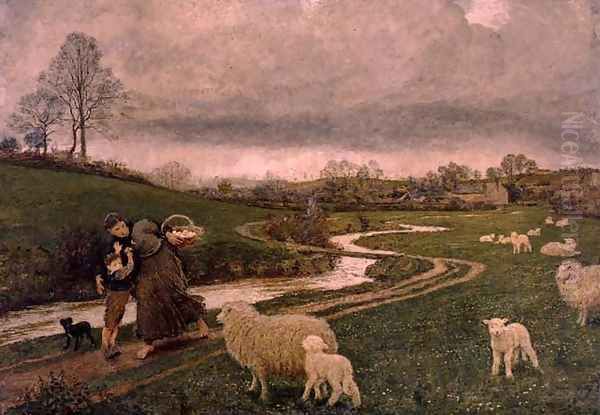
A defining characteristic of Walker's art is its "idyllic" quality. He often depicted rural life, but his scenes were rarely straightforward genre paintings. Instead, they were imbued with a lyrical, almost dreamlike atmosphere. His figures, whether labourers, children, or solitary wanderers, often seem caught in moments of introspection or quiet drama. There is a sense of timelessness in his best work, a feeling that he is capturing not just a specific moment but a universal human experience. This approach connected him with other artists of the "Idyllic School," such as George John Pinwell and John William North, who also sought to find poetry in the everyday.
Social realism, though often softened by his poetic lens, was another important strand in his work. He was sensitive to the hardships and vulnerabilities of ordinary people, particularly those living in poverty or on the margins of society. Works like The Vagrants (1868) address social issues with empathy and dignity, avoiding overt sentimentality while still evoking a powerful emotional response. He was influenced by the broader current of social concern in Victorian art, seen in the work of artists like Ford Madox Brown and, later, those he himself would influence, such as Luke Fildes and Frank Holl.
Walker's handling of landscape was also distinctive. His settings were not mere backdrops but integral parts of the narrative and emotional content of his paintings. He had a profound love for the English countryside, particularly the Thames Valley, and he rendered its gentle beauty with great sensitivity. His landscapes are often suffused with a soft, diffused light, creating a mood of tranquility or gentle melancholy. He paid close attention to natural detail – the texture of foliage, the play of light on water, the subtle gradations of colour in the sky – but always subordinated these details to the overall harmony and emotional impact of the composition.
Analysis of Key Works
Several of Frederick Walker's paintings stand out as iconic representations of his style and thematic concerns, earning him critical acclaim and a lasting place in British art history.
The Lost Path (1863): Exhibited at the Royal Academy, this oil painting marked Walker's significant entry into the world of fine art painting. It depicts a woman, possibly a widow given her dark attire, clutching a child, both looking distressed and lost in a bleak, snow-covered landscape. The starkness of the scene, the vulnerability of the figures, and the oppressive atmosphere of the winter weather combine to create a powerful image of hardship and despair. The painting demonstrates Walker's skill in conveying narrative and emotion through figurative composition and landscape.
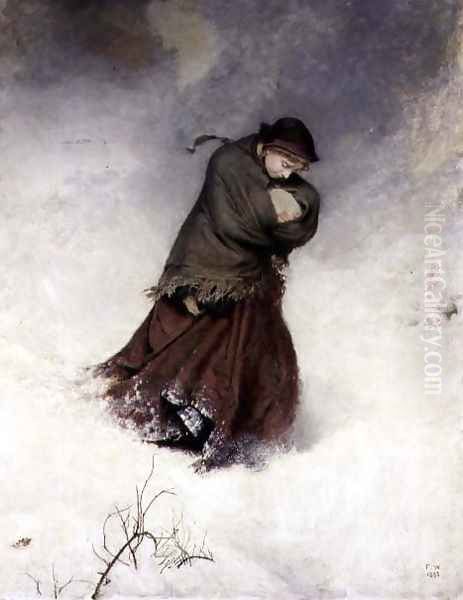
Strange Faces (1862, watercolour, later an oil version in 1867): This work, existing in both watercolour and oil, captures a group of curious children, their faces pressed against or peering through the bars of a gate or railing. Their expressions are a mixture of inquisitiveness, shyness, and perhaps a hint of apprehension. Walker masterfully conveys the unselfconscious intensity of childhood observation. The composition, with its focus on the varied physiognomies and the barrier that separates the viewer (or an unseen subject) from the children, creates a slightly unsettling yet engaging scene.
Philip in Church (1863, watercolour, based on an illustration for Thackeray's The Adventures of Philip): This watercolour, which won a medal at the Paris International Exhibition in 1867, is a tender and insightful depiction of a scene from Thackeray's novel. It shows the character Philip Firmin in church, his gaze directed towards the viewer or perhaps lost in thought, while other figures in the congregation are subtly characterized around him. The work is notable for its delicate handling of light and shadow, its psychological acuity, and its ability to translate a literary moment into a compelling visual narrative.
The Vagrants (1868, oil): This is one of Walker's most powerful social realist paintings. It depicts a family of itinerants – a woman with a baby, an older boy, and a younger girl – gathered around a small fire in a bleak autumnal landscape. A man, presumably the father, stands slightly apart, his back to the viewer, perhaps surveying their grim surroundings. The figures are rendered with a quiet dignity, their poverty and hardship evident but not sensationalized. The smoldering fire, offering little warmth against the encroaching chill, becomes a poignant symbol of their precarious existence. The painting was admired for its truthfulness and its compassionate portrayal of a marginalized group.
The Bathers (1867, oil): A departure from his more overtly social themes, The Bathers is a more classical and idyllic work. It shows a group of nude or semi-nude boys bathing and playing by a riverbank. The figures are rendered with an almost sculptural quality, reminiscent of classical friezes, yet they retain a naturalism and vitality. The painting celebrates the beauty of the human form and the innocent pleasures of youth, set against a lush, sun-dappled landscape. It reflects Walker's admiration for classical art and his ability to infuse it with a distinctly English sensibility.
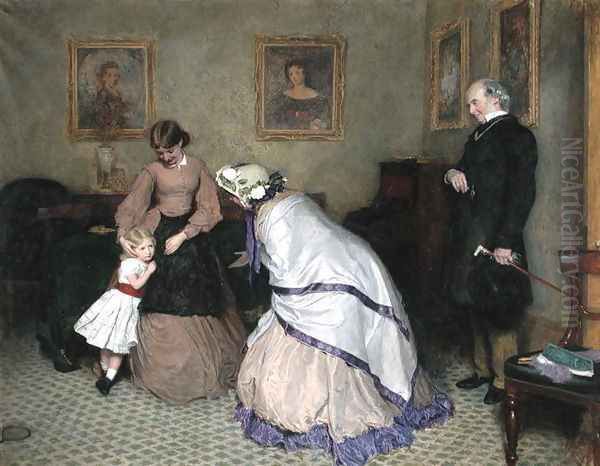
The Harbour of Refuge (1872, oil, later version known as The Old Gate): This is arguably Walker's most famous and poignant work. It depicts a group of elderly alms-people in the sunlit grounds of an almshouse, with a younger woman, a mower with a scythe, and a well-tended garden. The central focus is an old woman being gently guided by a younger one towards a stone bench. The scene is suffused with a golden, late-afternoon light, creating an atmosphere of peace and resignation. The figure of the mower with his scythe is a subtle memento mori, a reminder of the passage of time and the inevitability of death. The painting is a profound meditation on old age, memory, and the search for sanctuary. It was widely acclaimed and deeply resonated with the Victorian public. The Tate Britain holds a version titled The Old Gate (1869), which is a slightly different composition but shares the same essential themes and mood.
The Right of Way (1875, oil): One of his last major works, The Right of Way depicts a shepherd guiding his flock along a narrow path through a field, encountering a young, elegantly dressed couple who must step aside. The painting subtly explores themes of social class, tradition versus modernity, and the enduring rhythms of rural life. The figures are beautifully integrated into the landscape, and the scene is rendered with Walker's characteristic sensitivity to light and atmosphere.
The Idyllic School and Contemporaries
Frederick Walker is often associated with the "Idyllic School" of painters and illustrators, a loose-knit group active primarily in the 1860s and 1870s. These artists, while diverse in their individual styles, shared a common interest in rural subjects, poetic sentiment, and a nostalgic longing for a simpler, more harmonious way of life. Key figures in this group included George John Pinwell (1842-1875), a close friend of Walker's, John William North (1842-1924), and Arthur Boyd Houghton (1836-1875).
George John Pinwell, like Walker, began as an illustrator and later turned to watercolour and oil painting. His work often depicted scenes of poverty and rural hardship but, similar to Walker, imbued them with a poetic and sometimes melancholic beauty. Their shared sensibilities led critics to group them together as "poet-painters." Walker is known to have supported Pinwell, for instance, in the creation of a poster for Wilkie Collins's play The Woman in White.
John William North (often confused with his brother, the landscape painter William John North, with whom Walker also had connections) was another prominent member of this circle, known for his exquisitely detailed and atmospheric landscapes, often featuring solitary figures. The work of these artists, including Walker's, provided an alternative to the more heroic or didactic subjects favored by some academic painters, and also differed from the more overtly symbolic and medievalizing tendencies of the later Pre-Raphaelites like Dante Gabriel Rossetti or Edward Burne-Jones.
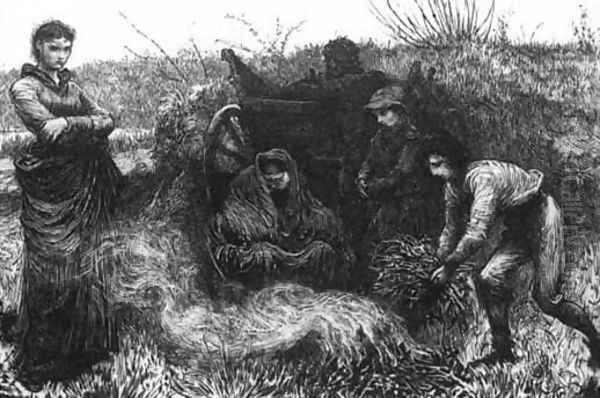
While the Idyllic School captured a particular facet of Victorian sensibility, Walker's art also existed within a broader artistic context. He admired the work of earlier British landscape painters like John Constable and J.M.W. Turner. The influence of the Pre-Raphaelites, particularly John Everett Millais in his earlier, more detailed phase, can be seen in Walker's meticulous rendering of natural detail, though Walker's overall mood and subject matter were generally softer and less intense. He was also aware of contemporary French realist painters like Jean-François Millet, whose depictions of peasant life resonated with Walker's own interest in rural labor, though Walker's approach was typically less rugged and more refined.
Influence and Connections
Despite his short career, Frederick Walker exerted a considerable influence on a number of younger artists, particularly those who came to prominence in the 1870s and were associated with the rise of British social realism. His ability to combine realistic observation with emotional depth and painterly skill provided a model for artists seeking to address contemporary social issues in their work.
Among the most notable artists influenced by Walker were Sir Luke Fildes (1843-1927), Frank Holl (1845-1888), and Sir Hubert von Herkomer (1849-1914). These artists, sometimes referred to as "The Graphic" artists due to their early work for the illustrated newspaper of that name, adopted Walker's compassionate approach to depicting the lives of the poor and marginalized. Fildes's famous painting Applicants for Admission to a Casual Ward (1874) and Holl's depictions of working-class life owe a debt to Walker's pioneering efforts in this genre. Herkomer's The Last Muster: Sunday at the Royal Hospital, Chelsea (1875), a poignant scene of elderly war veterans, shares a similar sensibility with Walker's The Harbour of Refuge in its dignified portrayal of old age and institutional life.
Walker's connections within the art world were extensive. His apprenticeship with Josiah Wood Whymper placed him at the heart of the illustration scene. His friendship with George John Pinwell was significant, and he also knew other illustrators like Charles Green and J.W. North. His work for Thackeray brought him into contact with the literary world, and he also provided illustrations for works by Charles Dickens, further cementing his reputation. He was respected by critics such as John Ruskin, though Ruskin's praise was sometimes qualified, as he found Walker's classicism occasionally at odds with his own ideals of pure naturalism.
His role in the Royal Watercolour Society was also important. He was a leading figure among a new generation of watercolourists who sought to elevate the status of the medium, employing techniques such as the use of bodycolour to achieve greater richness and depth, rivaling oil painting in its impact.
Later Years and Premature Death
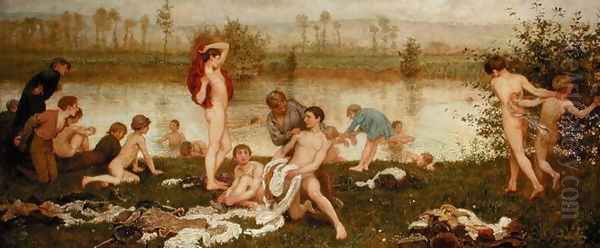
The final years of Frederick Walker's life were marked by declining health. He suffered from tuberculosis, a common and often fatal disease in the 19th century. Despite his illness, he continued to work, producing some of his most memorable paintings during this period. In 1873, seeking a warmer climate to alleviate his condition, he traveled to Algiers. The trip, however, did not bring the hoped-for improvement in his health.
He returned to Britain, his condition worsening. He spent time in Scotland, hoping the fresh air might prove beneficial. Tragically, Frederick Walker died on June 4, 1875, in St. Fillans, Perthshire, Scotland, at the young age of 35. He was unmarried and had lived with his mother and sister for much of his life. His early death was a significant loss to the British art world, cutting short a career that had already achieved so much and promised even greater things. He was buried in Cookham, Berkshire, a village on the Thames that he loved and often depicted in his work.
Legacy and Posthumous Reputation
Frederick Walker's death at such a young age meant that his oeuvre was relatively small, yet his impact was disproportionate to the length of his career. In the years immediately following his death, his reputation remained high. His works were sought after by collectors, and his influence on the next generation of social realist painters was widely acknowledged. Retrospective exhibitions of his work helped to solidify his place in the canon of Victorian art.
His art was praised for its unique blend of realism and poetry, its technical skill, and its profound humanity. Critics admired his ability to capture the subtle beauties of the English landscape and the quiet dignity of its inhabitants. He was seen as an artist who brought a new sensitivity and emotional depth to genre painting, elevating everyday subjects to the level of high art. His watercolours, in particular, were celebrated for their innovative technique and exquisite beauty.
Over time, as artistic tastes shifted in the early 20th century with the rise of modernism, the reputation of many Victorian painters, including Walker, experienced a period of decline. However, in more recent decades, there has been a renewed appreciation for Victorian art, and Walker's work has been reassessed and recognized for its unique qualities. His paintings are now held in major public collections, including Tate Britain, the Victoria and Albert Museum, and the British Museum.
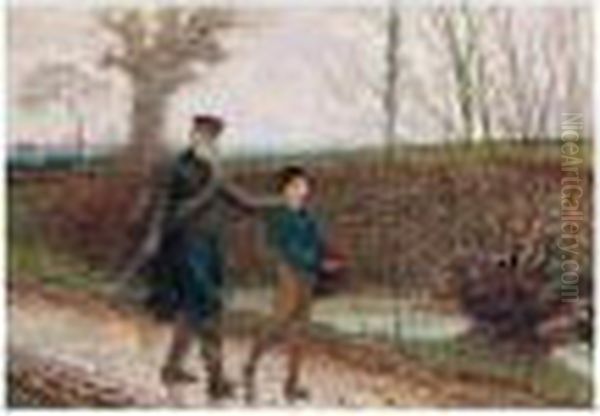
Walker's legacy lies in his distinctive artistic vision, his mastery of both oil and watercolour, and his compassionate portrayal of Victorian life. He successfully bridged the gap between illustration and fine art, bringing the narrative clarity and popular appeal of the former to the more ambitious compositions of the latter. He demonstrated that scenes of ordinary life, rendered with sensitivity and skill, could be as moving and profound as any historical or mythological subject. His influence on artists like Fildes, Holl, and Herkomer helped to shape the course of British social realism, ensuring that the concerns of the less fortunate remained a vital subject for artistic exploration.
Conclusion: An Enduring Poetic Vision
Frederick Walker was a shooting star in the firmament of Victorian art. In a career that lasted barely fifteen years, he produced a body of work that continues to captivate with its technical brilliance, its emotional resonance, and its gentle, poetic vision. From his early days as a meticulous illustrator to his mature achievements as a painter in both watercolour and oil, he pursued a singular path, creating art that was both deeply personal and universally appealing.
His depictions of rural England, his sympathetic portrayals of its people, and his poignant meditations on youth, age, and the human condition mark him as an artist of profound sensitivity and insight. While his life was tragically cut short, the luminous beauty and quiet power of his paintings ensure that Frederick Walker remains an important and cherished figure in the rich tapestry of British art. His ability to find the extraordinary in the ordinary, and to infuse his scenes with a timeless, idyllic quality, secures his enduring legacy.